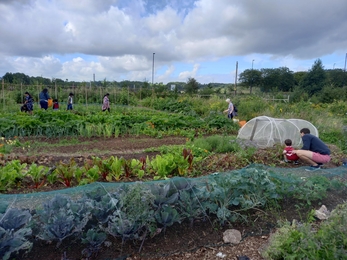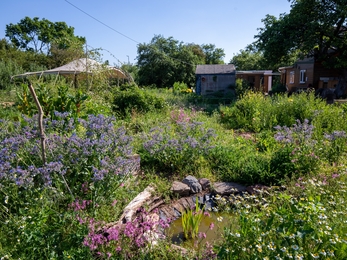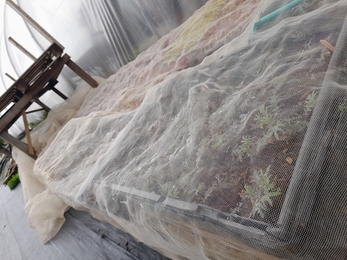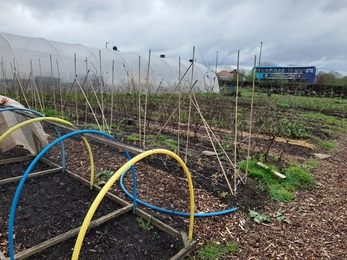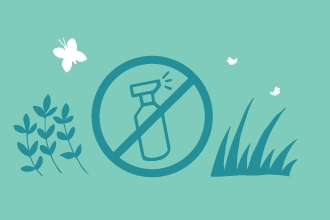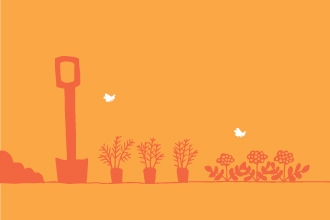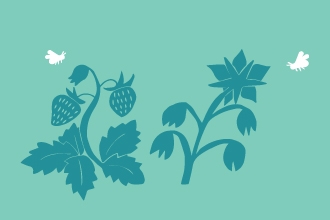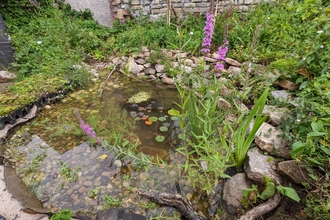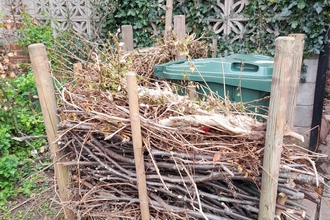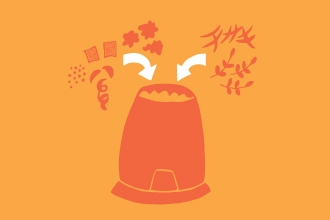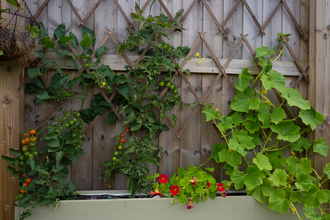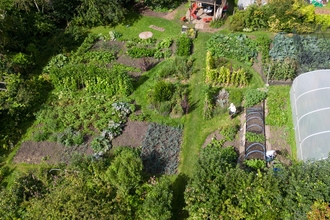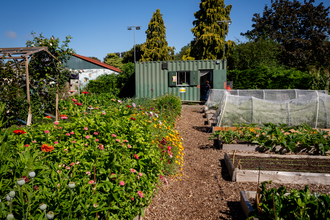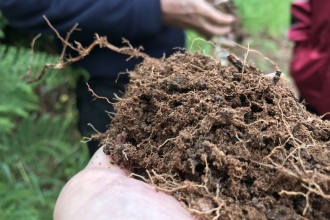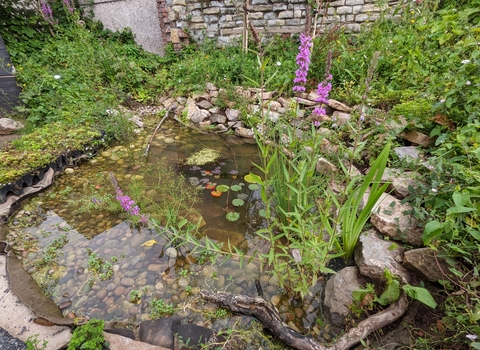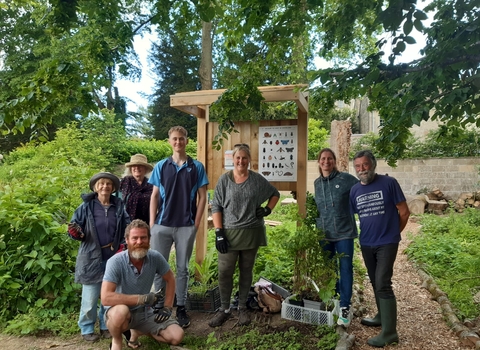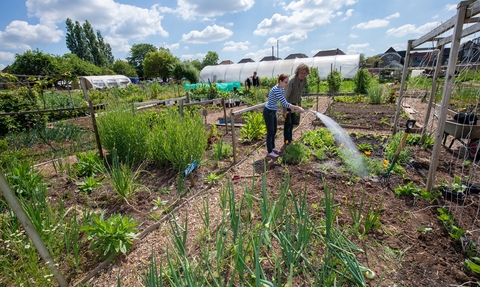
Nick Turner
Team Wilder Chemical-Free Gardening and Food Growing
What is chemical-free gardening?
What does it mean and look like to go chemical-free when gardening at home, in the allotment and in community spaces? Rosa from Grow Wilder shared some wisdom...
The ecological processes happening right now under our feet and in our gardens have taken thousands of years to evolve and continue in an ever-changing process of growth, life, reproduction, death, decay and regrowth. There are multiple ways to work with this cycle to get food, fuel, fibre and medicine out of your patch of soil. Working with nature, rather than against it, is key.
What is healthy soil?
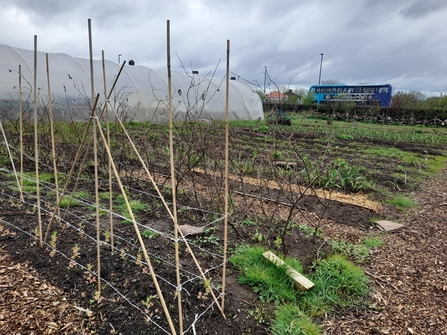
Sophie Bancroft
A healthy soil is a complex ecological web of living organisms, organic matter, minerals, water, gases, and bacteria. It facilitates plants to communicate with each other! The root-like structure of fungi (fungal mycelium) connects plant roots with the greater fungal body, exchanging soil minerals and sugars between fungi and plant.
Food growing chemicals include: fertilisers (adds soil fertility), pesticides (target insects), fungicides (target fungal life), herbicides (target problematic plant life/weeds). The continued application of these additives leaves soil life baron of the fundamental organic components that bind it together, enabling the ecosystem to take in carbon, absorb and retain water. Without water and organic matter, the soil struggles to nourish plant growth. Healthy soil grows healthy plants.
Challenges, ideas and practical examples
Challenges include fear of plants/seedlings being eaten and that pesticide-use is a large-scale farming issue, not in our ‘everyday lives’.
Small actions make a big difference and benefits of going chemical-free include healthy soil with tastier, organic food, stronger plants and thriving wildlife. Your garden or allotment is an ecosystem - find out what works for you.
Green manure
Healthy soil is living soil, full of roots, mycelium, water, and biological life. Keeping living roots in the soil year round plays a key role in water infiltration, reducing run off and soil degradation. All living roots excrete polysaccharides, a sticky substance which binds the soil together. Green manures are a useful tool that can be used year round, sown direct under your main crop or as an overwintering living mulch. Some green manures also bring the benefit of fixing nitrogen.
TIP: Cabbages, kale, cauliflower are all very nitrogen hungry plants with their big dark leaves, under sowing a clover green manure with your brassica crop allows them to access more nitrogen as well as supressing weeds and retaining soil moisture.
Habitat creation
- Ponds, wild patches, log piles and hedges encourage natural predators, such as frogs, ladybirds and hedgehogs who eat slugs and aphids.
- Slow worms shelter under corrugated metal and love a good slug-feast!
Learn more about wildlife gardening
TIP: Nettles attract ladybirds and are loved by butterflies, plus you can harvest them to make healthy nettle soup or nettle tea. It's beneficial to let some nettles grow on your allotment or veg patch. They're also great for compost tea (see instructions below).
Planting out
- A variety of plants will increase resilience.
- Over sow seedlings, and plant out more than you need at each stage, banking on the fact some are going to get eaten.
Companion planting
- Sacrificial plants - e.g., Nasturtiums attract aphids away from vegetable crops and repel ants and whitefly.
- Deterrent plants - e.g., the allium family (onion) all have a strong smell & can deter unwanted insects
- Beneficial plants encourage pollinators - e.g., Sarah in BS9 grows ‘poached egg plants’ with French beans. Chamomile acta as a tonic for sick plants and encourages growth.
Companion planting at Grow Wilder (https://www.youtube.com/watch?v=jj3KcDC_KZ0)
Emma Fennell Hodson
Pest control barriers
- Tom in BS3 puts wool or copper around new plant growth to deter slugs.
- Horticultural fleece or mesh.
- Cloche (repurposed plastic bottle) around young seedlings.
TIP: Wool insulation from vegetable boxes are ideal to protect seedlings from slugs, as recommended by Sarah in BS9.

Marian Hill
Soil improvement - compost making
Compost making is an essential part of any growing space, recycling your plant cuttings and food waste back into a growing substrate will save you money and build healthy soil.
In your compost aim for a ratio of 25% brown organic matter (carbon, eg. cardboard or wood chip) and 75% green organic matter (nitrogen, eg grass cuttings, food waste). Be sure to layer these components, for example, every time you empty your food waste in the compost cover it with a wheelbarrow of woodchip, this will deter pests (rats/mice) and speed up the decomposition process.
Grow Wilder compost (pictured below) uses 6 compartments to effectively rotate and use rich compost soil when ready.
‘Compost tea’ made out of comfrey, nettles or horsetail - makes an excellent, concentrated, liquid feed to help fertilize new plant growth. This builds stronger walls on developing plants, increasing resilience to pests.
ADVICE: Compost teas are worthwhile experimenting with, especially if you have a patch of nettles or comfrey in your garden.
Melissa in BS2 has a wormery to break down food waste and create an intense, rich fertilizer for growing vegetables.
TIP: A wormery works best as a sealed unit with food waste, excluding foods cooked with oil and egg shells as they're difficult to break down.
Compost making at Grow Wilder (https://www.youtube.com/watch?v=BeQ3jWwJ6rs)
Emma Fennell Hodson
Philip Precey
Spotlight on comfrey: Comfrey is a favourite among organic growers for its nutrient rich leaves that make perfect homemade liquid feed fertiliser, which is rich in potassium and nitrogen. Comfrey is also a ‘dynamic accumulator’ deep rooting plant that draws minerals up from deeper soil inaccessible to other plants. The comfrey bocking hybrid has been bred to be sterile so it won’t self seed and become invasive. It is hardy and well-loved by pollinators!
Comfrey makes an excellent feed for tomatoes and beans. Comfrey leaves can also be dug into root and tuber vegetable crops as a slow release fertiliser, making potatoes more tasty! The flowers help to attract beneficial pollinators to neighbouring vegetable crops, encouraging higher yields.
GROWING ADVICE: Comfrey commonly grows in allotments or plant in an unused corner of your garden in moist, well-drained soil. Can be grown in sun or partial shade in any garden facing. Prefers moderately fertile soil. Can be divided and propagated in spring or by root cuttings in early winter for free plants.
HOW TO MAKE COMFREY TEA: Install a tap 5” from the base of a large, lidded container/bucket/wheelie bin. Fill the container with freshly picked comfrey leaves, and weigh them down with a mesh and stones, allow the leaves the ‘self juice’ as they decompose. Tap off the liquid into a sealable container (old milk carton). Store in a cool place until needed. Mix 10 parts water to 1 part comfrey. At Grow Wilder, it is used on the first water of their plug plants when they have been transplanted.
For more working examples of growing food chemical-free and for advice from staff and volunteers, visit Grow Wilder.
SHARE YOUR ACTIONS AND INSPIRE OTHERS
Talking about being chemical-free, sharing tips and experiences (good and bad!) will encourage others. What works on one plot of land might not work on another – but it’s worth trying and learning. Benefit from letting nature do its job and growing healthy, organic food, flowers and plants.
How to take action against pesticide use
Advice from James Byrne, Director and founder of Pesticide-Free Scotland:
- Do your research on the pesticide usage of the Council (using an Freedom of Information request) and pesticide alternatives?
- Build support via residents (if you can get children and schools asking for it, even better), other local groups, councillors and MPs to advocate for pesticide reform.
- Get local press onside and interested in the topic of pesticide usage – even use letters to the editor.
- Ask PAN UK for a Pesticide-Free logo personalised for your area.
- Write to the Chief Executive and Leader of the Council about pesticides usage, legal obligations, precautionary principle, alternatives and offer demonstrations and trails of pesticide-free alternatives
- Hold discussions with the Council's Head of Land Management Services, PAN UK and other important stakeholders.
- Continue steps 2, 3 and 6.
My final advice would be not to give up, we are on the right side of history, every action no matter how small builds momentum. Every email, letter, tweet to your elected officials builds that momentum. Tell your neighbours, friends, schools, workplace etc. why pesticides are poison. Talk to the chaps at PAN UK and other campaigners on PAN's forum for help, advice and inspiration. Remember, if not you, who?
Read the full blog about taking action against pesticide use
Resources
Go wild for worms
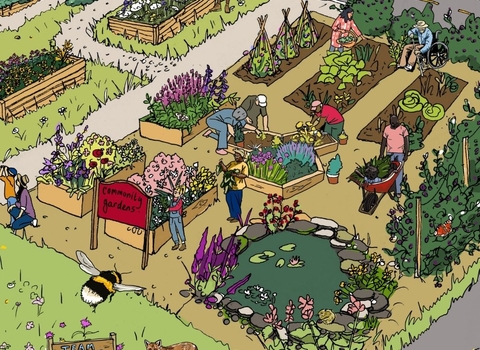
(C) Hannah Bunn
Be part of Team Wilder
All actions for nature collectively add up and creates life for people and wildlife.
Share your actions for nature, like Tom by sharing and tagging @avonwt on social media and
Log your actions for nature on the map

